Plant Sales Live on JuliaRedman.com
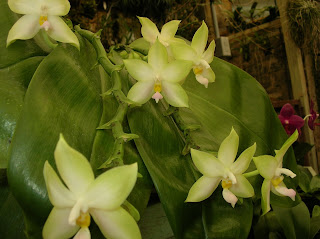 (Left: Phal. violacea v. alba at The Little Greenhouse)
(Left: Phal. violacea v. alba at The Little Greenhouse)
Recently a news article was cited on the Orchid Guide Digest by Viateur, who finds all the interesting stories for us. The article makes two claims that are interesting, but unsupported (references are not cited). Do any of you know if these are accurate statements?
"Translucent pots allow light to reach the roots and algae to form on their
surface [is that desirable ?] ? this helps with moisture and nutrient uptake.
...
Moth orchids are effective in removing xylene (chemical emissions from
adhesives, computer VDU screens, paints, photocopiers and varnishes) from
the atmosphere [really ?]"
 Observe the tastiness...
Observe the tastiness...
Last night I made a gluten-free pumpkin spice cake using a recipe I found through a newly discovered blog, called the Gluten Free Blog of course! It might be my new favorite blog for a while!
Modifications I made to the recipe:
(1) Used Rob's Red Mill gluten free flour blend instead of the individual flour types listed
(2) Omitted the nuts, didn't want
(3) Substituted 1/2 cup of the plain sugar for brown sugar
It is most tasty served with ice cream or cream cheese. It would also be wonderful with a cream cheese buttercream frosting. mmmm... The texture of the cake is wonderful. You'd never know it wasn't a "normal" cake. Mike Eberhart over at the Gluten Free Blog really knows his medium. Its much better than the gluten free zucchini bread that I made last week using the recipe on the back of the xanthan gum I purchased. Either I did something wrong or the recipe is poor, but the stuff did not rise. It sayed as flat as when I put it in the pan. It tastes ok, especially with liberal application of creme cheese, but the texture is flat and a little gummy. The cake on the other hand - fabulous! I think I'll have to buy a copy of Mike's book.
The texture of the cake is wonderful. You'd never know it wasn't a "normal" cake. Mike Eberhart over at the Gluten Free Blog really knows his medium. Its much better than the gluten free zucchini bread that I made last week using the recipe on the back of the xanthan gum I purchased. Either I did something wrong or the recipe is poor, but the stuff did not rise. It sayed as flat as when I put it in the pan. It tastes ok, especially with liberal application of creme cheese, but the texture is flat and a little gummy. The cake on the other hand - fabulous! I think I'll have to buy a copy of Mike's book.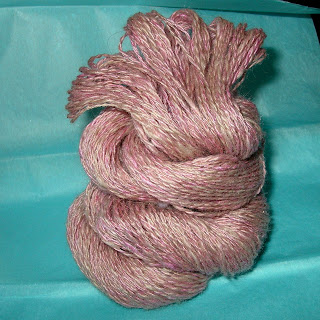 In other news, I've had a small milestone with my spinning activities, thanks to some nice mostly camelid fiber. This is "little bunny", the finest 2-ply yarn I've ever spun and I'm quite pleased with it. The fiber was prepared just right and so was quite willing to be spun fine. The result is 50g of ~16wpi yarn, making it fine or sport weight. It is a blend of llama, baby camel, silk, and flash. The name is simply based on the way the pile of yarn in the photo looks like a perky little bunny sitting on his haunches.
In other news, I've had a small milestone with my spinning activities, thanks to some nice mostly camelid fiber. This is "little bunny", the finest 2-ply yarn I've ever spun and I'm quite pleased with it. The fiber was prepared just right and so was quite willing to be spun fine. The result is 50g of ~16wpi yarn, making it fine or sport weight. It is a blend of llama, baby camel, silk, and flash. The name is simply based on the way the pile of yarn in the photo looks like a perky little bunny sitting on his haunches.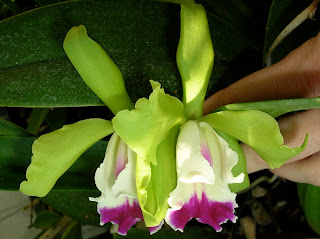 And so that we are not without flower photos in this post, here is Lc. Green Veil 'Dressy', currently in bloom with 2 flowers on each of 2 growths. Its a wonderful shade of green with a delightful contrast in the lip, don't you agree? I'm going to pollinate it with my Sc. June Bug 'Venice Sunshine'. Not that I really have any business making cattleyas, but you know, they really are easy to grow. I think they're about the easiest thing to grow from seed next to phals.
And so that we are not without flower photos in this post, here is Lc. Green Veil 'Dressy', currently in bloom with 2 flowers on each of 2 growths. Its a wonderful shade of green with a delightful contrast in the lip, don't you agree? I'm going to pollinate it with my Sc. June Bug 'Venice Sunshine'. Not that I really have any business making cattleyas, but you know, they really are easy to grow. I think they're about the easiest thing to grow from seed next to phals.
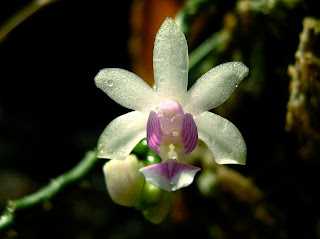 Kingidium deliciosum, also known as Phalaenopsis deliciosa, is a miniature species. The name 'deliciosa', which means "delicate", refers to the appearance of the flowers. They have a very crystalline, thin appearance. They are typically born singly or twos on an inflorescence in sequential fashion, much like Paph. Pinocchio, and can have more than one inflorescence at a time. Individual flowers don't seem to last long, but the plant does produce many over time. Also, the leaves are interesting thanks to a slightly ruffled margin.
Kingidium deliciosum, also known as Phalaenopsis deliciosa, is a miniature species. The name 'deliciosa', which means "delicate", refers to the appearance of the flowers. They have a very crystalline, thin appearance. They are typically born singly or twos on an inflorescence in sequential fashion, much like Paph. Pinocchio, and can have more than one inflorescence at a time. Individual flowers don't seem to last long, but the plant does produce many over time. Also, the leaves are interesting thanks to a slightly ruffled margin.
I find it to be easy to grow and flower. This one lives on a cork mount and seems quite tolerant of the occasional drought.
RHS uses the name Kingidium for registration purposes. Only a few hybrids are attributed to the species. Many of the small species have been left behind for hybridization, probably because of a combination of size (little ~ not impressive or easily overlooked?) and in some cases difficulty of growing and breeding them. For this one, there is also the somewhat undesirable characteristic (for a Phalaenopsis) of not carrying many flowers at once. I have no idea how easy this one is to breed, but I'm going to give it a shot using the Phal. equestris alba from my previous post. If it works, we'll get little plants perfect for windowsills, and more flowers than deliciosum, though maybe not as many as equestris. That's ok, equestris does produce an obscene number of flowers! I pollinated the plant today. Let's all cross our fingers!
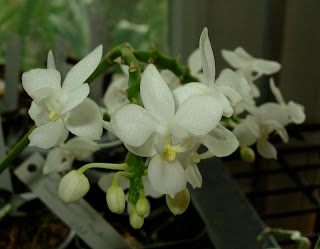 Main reason why Phal. equestris is cool: TONS of flowers. This is a first bloom seedling with a 3-way branched spike. I've seen some make 2 spikes like this. And they just go on and on, making new flowers. Many of the 'multifloral' hybrids have equestris somewhere in there history, contributing the multitude of flowers characteristic. This plant is about to join the ranks of pollen donors in my house.
Main reason why Phal. equestris is cool: TONS of flowers. This is a first bloom seedling with a 3-way branched spike. I've seen some make 2 spikes like this. And they just go on and on, making new flowers. Many of the 'multifloral' hybrids have equestris somewhere in there history, contributing the multitude of flowers characteristic. This plant is about to join the ranks of pollen donors in my house. 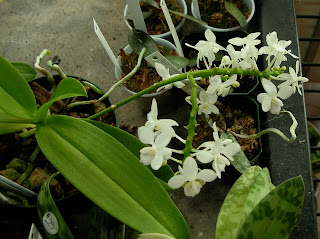 They are also a species that is prone to making keikis. An individual fan of leaves will stay relatively small, but as they mature and produce a mountain of keikis the plant can become quite impressive. Alternatively, you can remove the keikis and share them with your friends like so many summer squash! For more information on growing phalaenopsis, see this post.
They are also a species that is prone to making keikis. An individual fan of leaves will stay relatively small, but as they mature and produce a mountain of keikis the plant can become quite impressive. Alternatively, you can remove the keikis and share them with your friends like so many summer squash! For more information on growing phalaenopsis, see this post.
 (Left: Phal. violacea v. alba at The Little Greenhouse)
(Left: Phal. violacea v. alba at The Little Greenhouse)






